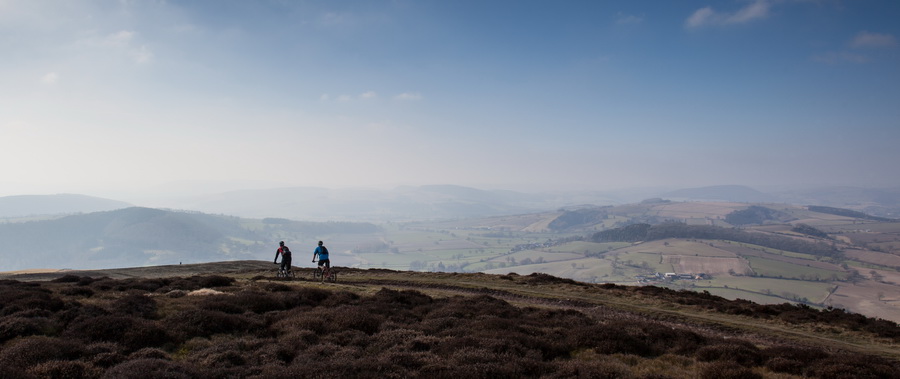News
Areas of Outstanding Natural Beauty Renamed National Landscapes
New name and brand underpin ambitious targets for nature
Today, [Wednesday 22 November] all designated Areas of Outstanding Natural Beauty (AONBs) in England and Wales are becoming National Landscapes. The Shropshire Hills National Landscape covers around a quarter of the county, extending from the Wrekin to the Clun Forest and from the Stiperstones across to the Clee Hills.
The new name reflects the national importance of these landscapes; the vital contribution they make to protect the nation from the threats of climate change, nature depletion and the wellbeing crisis, whilst also creating greater understanding and awareness for the work that they do.

This is a significant milestone for the UK and the next step in fully realising the National Landscapes’ vision to be the leading exemplars of how thriving, diverse communities can work with and for nature in the UK: restoring ecosystems, providing food, storing carbon to mitigate the effects of climate change, safeguarding against drought and flooding, whilst also nurturing people’s health and wellbeing.
National Landscapes teams have been at the forefront of delivering natural solutions to the main challenges facing the nation for many years. The new brand underscores their commitment to redoubling their efforts and engaging with a wider audience. In 2019, teams set themselves the most ambitious targets for nature in the sector and continue to work to meet them.
By 2030, National Landscapes aim that, within their boundaries: at least 200,000 hectares of the most valuable natural areas (Sites of Special Scientific Interest or SSSIs), which equates to 1 ¼ times the size of London, will be in favourable condition; 100,000 hectares of wildlife-rich habitat outside of SSSIs will be created or restored, which is roughly nine times the size of Manchester; and 36,000 hectares of woodland, which is a little smaller than the Isle of Wight, will have been planted or allowed to regenerate. National Landscapes Partnerships will also focus on habitat restoration to ensure the protection of some of our most endangered species and increase their work to help more people to enjoy time spent in beautiful places.
Because of their size and scope, National Landscapes are ideally positioned to address the environmental issues the UK is facing. There are 46 National Landscapes in the UK, covering 14% of England, Wales and Northern Ireland including moorland, farmland, coast, forests, including UNESCO World Heritage Sites, Biosphere Reserves, a Geopark and International Dark Sky Reserves. They are the UK’s nearby countryside - 66% of people in England (44 million) live within 30 minutes of a National Landscape and at least 170 million people visit them every year.
Alex Carson-Taylor, Chair of the Shropshire Hills National Landscape Partnership says:
“Renaming to the Shropshire Hills National Landscape highlights the nationwide importance of our area and reflects the status and diversity of our landscapes, communities, biodiversity, land use and economic activity. Working under the identity of the Shropshire Hills National Landscape will enhance our ability to collaborate with local and national partners and deliver on key issues including climate change mitigation, sustainable land use, nature recovery and resilient rural communities.”
John Watkins, Chief Executive of the National Landscapes Association says:
“For decades, AONB teams have convened powerful partnerships which have placed them at the forefront of the fight against climate change and biodiversity loss, but since their initial designation, our country has changed immensely, as have the needs and pressures on the environment and communities. However, we have great ambition as well as the commitment and readiness to care for and protect these important places, whilst also extending a welcome to more people. Our ambitious aims build on AONB teams’ long track record of successful delivery for nature and people and we are confident that we will achieve them. National Landscapes are the landscape designation for the 21 Century and beyond.”
Tony Juniper, Chair of Natural England says:
“For decades the AONBs have helped protect the beauty of our finest landscapes. Today though we need so much more from these wonderful places, helping us adapt to climate change, catching carbon, restoring depleted wildlife and encouraging more people outside, at the same time as producing food, sustaining local communities and enhancing historic environments."
“Modern challenges require new approaches and today marks the beginning of a new phase for our National Landscapes, as they strengthen their existing partnerships, and forge new ones that will secure in perpetuity the huge range of benefits that come from these special places. Big change has taken place during the past 75 years and bigger changes still can be expected during the decades ahead. Uniting the National Landscapes in this way is very welcome and spells immense opportunity and great hope for the future.”
-ENDS-
View film ‘Welcome to National Landscapes’ here https://youtu.be/3DPQbwGv-4o (published 12.01 Wednesday 22 November)
Published by Shropshire Hills National Landscape on (modified )
